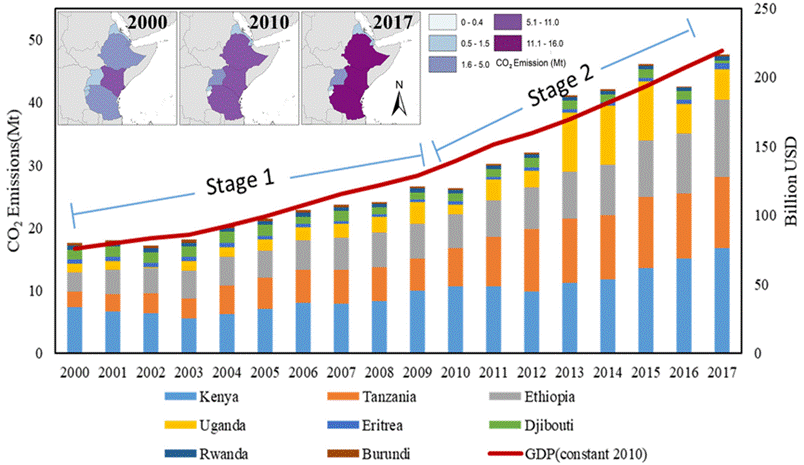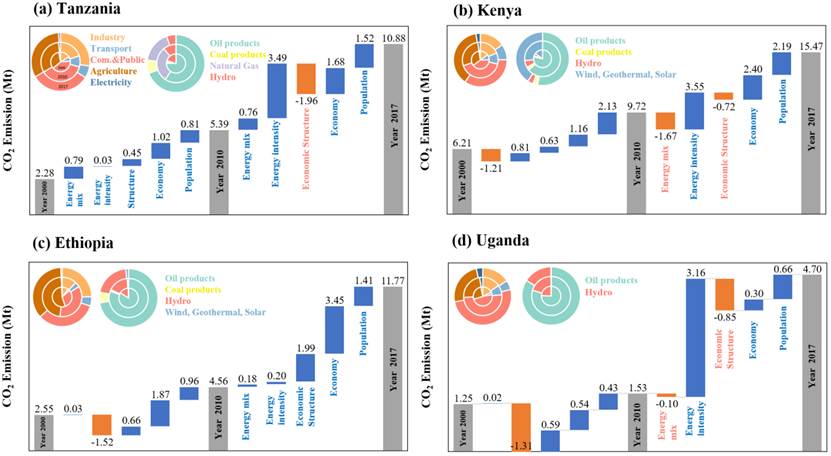International efforts to mitigate climate change have historically focused on reducing energy-related CO2 emissions from developed economies, including the EU and the U.S., or countries with the largest populations, such as China and India, and a series of emission reduction policies has been implemented. But attention to the current situation of climate control in underdeveloped areas is lacking. More and more developed countries have achieved or are about to achieve carbon peaking. Most of the "least developed countries", represented by countries in the East Africa region, have made their own emission reduction commitments, but are constrained by their weak data base, making it difficult to formulate reasonable emission reduction policies. A detailed and scientific carbon emission inventory is the basis for formulating emission reduction policies, and the building of carbon data is of great significance to the sustainable development of underdeveloped countries and the global carbon neutrality path planning.
To address the above problems, Prof. Guan Dabo's Research Group of the Department of Earth System Science (DESS), Tsinghua University, in collaboration of several research teams at home and abroad, based on multi-source data, rebuilt the 45-sectors carbon emission inventories of eight East African countries from 2000 to 2017, and used index decomposition analysis to quantify the drivers of growth. This study has filled in gaps in the carbon data of international mainstream energy data institutions such as IEA and EDGAR for underdeveloped areas, and revealed the carbon emission growth pattern and reduction path in underdeveloped economies amidst their economic development represented by the East Africa region. The research results were published online in Applied Energy, an international mainstream journal in the field of energy and environment, as a paper titled "Emission accounting and drivers in east African countries".
According to research, emissions in East Africa have been rising at an average annual rate of 6.03%, nearly tripling from 17.6Mt in 2000 to 47.6Mt in 2017, and showing a two-stage exponential growth pattern with 2010 as the turning point. At the same time, the region's rapid economic growth, with an average annual GDP growth rate of 6.45%, is highly consistent with emissions in terms of trends, with economic growth linked to emissions. Since 2010, the rate of increase in emissions has accelerated and gradually exceeded the rate of GDP growth, implying that without aggressive action on energy mix and energy efficiency, future growth per unit of GDP in East African countries will come at the cost of higher emissions.

▲Fig. 1 Temporal and spatial evolution of CO2 emissions in the East Africa region 2000-2017
The results of the two-period LMDI decomposition show that economic and population growth in East Africa are responsible for 13Mt and 11Mt of emission growth from the year 2000 to 2017, respectively. After 2010 the region's economic development process became significantly more energy intensive in such sectors as transportation, construction and nonmetal manufacturing, becoming an important driver for emission increase by 9.8Mt. While the energy mix is generally improving, the potential for emission reductions from hydro and geothermal energy development is almost offset by the growing demand for oil and coal, leaving the energy mix as a weak driver of emission reductions (1.44Mt). Improvements in the energy mix are far from sufficient to remove the pressure on total energy consumption from economic activity and population growth in East Africa.

▲ Fig. 2 Evolution of CO2 emissions in four high-emission economies in the East Africa region 2000-2017
This study points out that as underdeveloped economies often face the double challenges of economic development (poverty alleviation) and emission reduction, emission reduction policies should focus more on improving energy efficiency and optimizing energy structure, rather than limiting industrial growth. Governments should make full use of their own unique renewable energy endowment, increase the proportion of foreign investment in clean energy development expenditure, and develop characteristic commercial agriculture and forestry according to national conditions, so as to realize the synergistic effects of employment, emission reduction and economic growth.
Sun Yida, a doctoral candidate of DESS, Tsinghua University, is the first author of the paper, and Associate Professor Shan Yuli of University of Birmingham is the corresponding author of the paper. Other collaborators include Professor Guan Dabo of Tsinghua University, Cui Can, a doctoral candidate of Tsinghua University; Zhao Weichen, a doctoral candidate of University College London; Wang Daoping, a doctoral candidate of Shanghai University of Finance and Economics; Professor Zhang Zhenke of Nanjing University; Hao Qi, an undergraduate of Nanjing University. The research was supported by the National Natural Science Foundation of China (No.41921005).
Full-text link: https://www.sciencedirect.com/science/article/pii/S0306261922002525
Written by Sun Yida
Edited by Wang Jiayin
Reviewed by Zhang Qiang